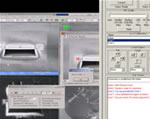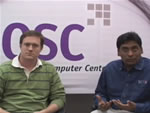|
|
|
Project provides wider access to and greater return on large investments
Engineers at the Ohio Supercomputer Center are enabling academic and industrial researchers to remotely access, in real time over the Internet, some of Ohio’s most expensive and important scientific instruments.
The Ohio Board of Regents has funded a “shared instrumentation” pilot research project to gain a greater return on large investments in extraordinary instruments such as electron microscopes, nuclear magnetic resonance spectrometers, Raman spectrometers, and ion accelerators at Ohio universities. Electron microscopes, for example, can cost a university $450,000 to $4 million to purchase and require yet more funding for operation and maintenance.
“These scientific instruments represent a valuable asset in the state and can fuel the development of new products and technological innovation, as well as to expand the frontiers of knowledge,” said Eric Fingerhut, chancellor of the Ohio Board of Regents.
“In Ohio today, we are transforming our system of higher education to focus on collaboration, not competition, to meet the needs of the state and its citizens. This unique resource-sharing project will allow Ohio’s colleges and universities to multiply the benefit of each strategic investment made in scientific instrumentation,” he said.
To address this challenge, Prasad Calyam, a senior systems developer at OSC, and his colleagues have developed the Remote Instrumentation Collaboration Environment (RICE) – a unique software package that Calyam will describe to international colleagues in a presentation Oct. 11 in Verona, Italy, at the First International Conference on Immersive Telecommunications.
The RICE project dovetails with another recent Regents initiative that provides industry and defense-lab researchers with remote access to microscopes at The Ohio State University’s Center for the Accelerated Maturation of Materials (CAMM). The OSU research center, which recently installed several of the world's most powerful electron microscopes, has been a crucial partner in the RICE software development process, sharing equipment, expertise, and other vital resources.
“This software provides high-quality, easy-to-use access to users who do not have access to or cannot afford equipment like electron microscopes,” said Calyam, who is a doctoral student in electrical and computer engineering at OSU. “RICE allows researchers to control the microscope in real time (tele-operation) as they examine a sample, or it can restrict remote users to just viewing the sample’s images and communicating with the operator (tele-observation), as may be the case with students and researchers not familiar enough with using the instrument.”
One of the advanced features of the RICE software allows for multiple remote users, who pass control of the instrument back and forth as needed, according to Calyam’s software development colleague, Abdul Kalash, an OSC graduate research associate and fellow OSU graduate student. To facilitate communication, the RICE software provides users with Voice over IP and text chat.
A significant challenge faced by the software developers was the problem of handling network bandwidth limitations and congestion. Image delays caused by network issues might result in a user needlessly repeating a command that could eventually cause the instrument to malfunction, or even worse, extensively damage physical components that are prohibitively expensive to repair.
“Remote microscopy is a very demanding, network-based multi-media application,” said Calyam. “It is comparable to other applications of its class, such as Internet gaming, high-definition videoconferencing, and IPTV.”
Fortunately, network issues at Ohio’s universities are relatively minor because of their connections to OSCnet, the nation’s leading statewide, fiber-optic network dedicated to education, research, and economic competitiveness.
However, for situations where “last-mile” connections to the network backbone are limited or experiencing heavy traffic, the RICE interface analyzes if the response-time is reaching a critical imbalance. In such cases, it has a mechanism that will momentarily reduce the resolution of the image, warn the user about bandwidth limitations, and if necessary, even block user input until adequate bandwidth is again available.
Calyam is working to develop the RICE prototype into a full-featured, open-source application and is working with colleagues at OSC to create a web-interface for the software, one of several “portals” being developed by the newly formed Cyberinfrastructure and Software Development Group at OSC. Under the umbrella of OSC’s Blue Collar Computing initiative, the group is creating education, industry, and instrumentation and analytics portals to provide wider access to the significant networking, computing, and storage resources at the center and around the state.
“In addition to CAMM, instrument labs at the OSU Department of Chemistry, Miami University Electron Microscopy Facility, and Ohio University Department of Physics and Astronomy are also participating in the shared instrumentation pilot project,” said Ashok Krishnamurthy, senior director of research at OSC. “As more progress is made on the instrumentation and analytics portal, valuable instruments at other universities in Ohio will be available to researchers through the shared instrumentation service.”
The ultimate goal, according to Calyam, is to “integrate RICE into a cyberinfrastructure for a remote instrumentation service that is easy to use and maintain. This service also will improve user convenience, significantly reduce costs, and, ultimately, decrease duplication of instrumentation investments across the state.”
Celebrating 20 years of service, the Ohio Supercomputer Center (OSC) is a catalytic partner of Ohio universities and industries that provides a reliable high performance computing and high performance networking infrastructure for a diverse statewide/regional community including education, academic research, industry, and state government. OSC promotes and stimulates computational research and education in order to act as a key enabler for the state's aspirations in advanced technology, information systems, and advanced industries. For additional information, visit http://www.osc.edu.

